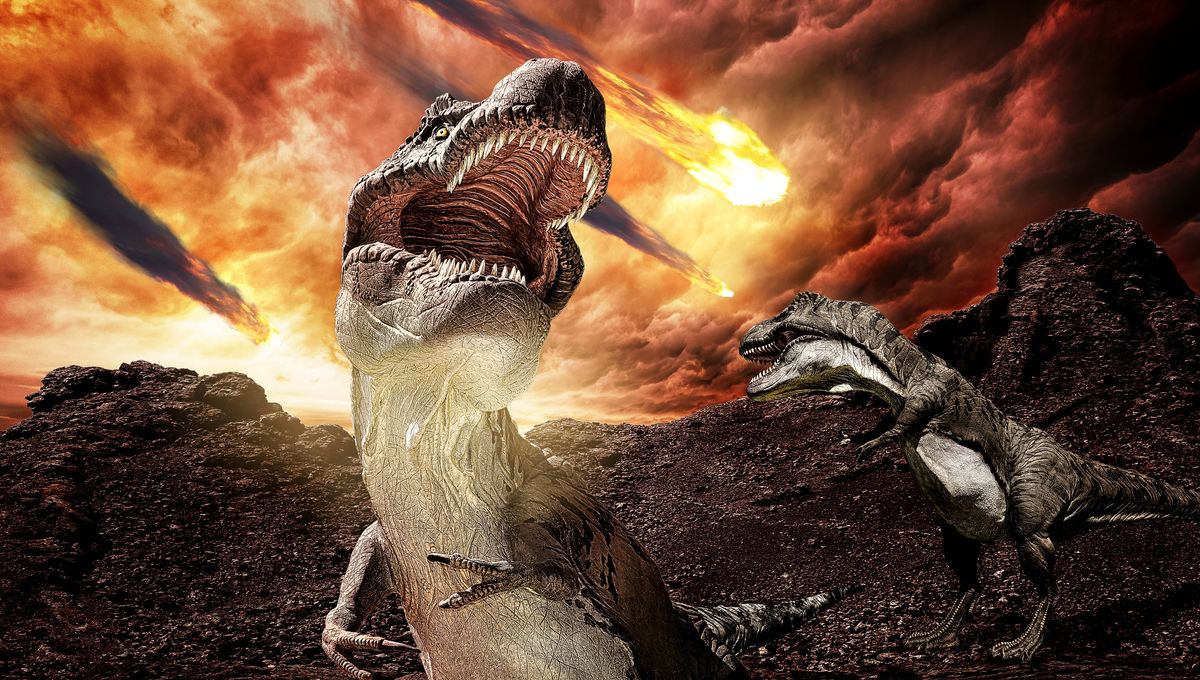
The small group of paleontologists that argue an outburst of volcanic activity rather than a massive asteroid impact was the underlying cause of the mass extinction that wiped out the largest animals to walk the Earth has received some inhuman support for their position. Others, however, argue that the way you phrase the question can shape the answer, and what is true for humans applies even more strongly for computers.
To most people, the debate about what killed the non-avian dinosaurs was settled decades ago. We found the impact crater, the layer of metals from the asteroid, and the soot from the fires the impact started, with no dinosaur bones thereafter. Case closed, and to add a few more nails, we’ve found fossils from the very day the asteroid hit. Yet in the relevant fields, including geology and the biology of the era, a minority remains unconvinced.
Although they acknowledge the asteroid (or comet) was devastating, this group argues the end of the dinosaurs was a slow-moving mass extinction, with global ecology unbalanced by volcanism. Unable to convince the scientific or popular majority, supporters of this view have found a new ally in artificial intelligence (AI).
Dartmouth University graduate student Alex Cox fed more than 100 processors with geological and climatic data from the relevant era and had them explore the fossil record to see what might have caused extinctions around the Cretaceous-Paleogene boundary. The system Cox and his supervisor Dr Brenhin Keller developed implies a different conclusion from most of the thousands of scientists who have explored the same data – but which is more reliable?
Those who favor volcanoes as the true cause of the problem point to the 1.3 million cubic kilometers of basalt known as the Deccan Traps, which were laid down around the same time. Similarly-sized volcanic provinces elsewhere in the world have been associated with previous mass extinctions through the climatic changes unleashed by the gasses that accompanied all that lava.
Much of the debate has been fought over whether dinosaurs and other species were in decline prior to the impact that formed the Chicxulub crater, or if there was just the usual turnover of species.
Cox and colleagues looked at the evidence we have for changing levels of carbon dioxide and sulfur dioxide in the atmosphere, and the consequences for the planet’s temperature, over a 2-million-year period before and after the Cretaceous’s end. Using a machine-learning model the pair noted resembles predictive text, the processors sought to work out which of 300,000 scenarios provided the most likely explanation.
“Part of our motivation was to evaluate this question without a predetermined hypothesis or bias,” Cox said in a statement. “Most models move in a forward direction. We adapted a carbon-cycle model to run the other way, using the effect to find the cause through statistics, giving it only the bare minimum of prior information as it worked toward a particular outcome. In the end, it doesn’t matter what we think or what we previously thought — the model shows us how we got to what we see in the geological record.”
By a remarkable coincidence, the eruptions that produced the Deccan traps started around 300,000 years before the Chicxulub impact and continued for twice as long afterward.
Although the computers noted a plunge in biological activity after the impact on a timescale too short to be from volcanism, they also indicated the climate changes required for a mass extinction were probably from the Traps alone.
“Our model worked through the data independently and without human bias to determine the amount of carbon dioxide and sulfur dioxide required to produce the climate and carbon cycle disruptions we see in the geologic record. These amounts turned out to be consistent with what we expect to see in emissions from the Deccan Traps,” said Keller.
In other words, most dinosaurs might have been done for, even without the asteroid.
Whether Cox and Keller’s outcome wins wide acceptance is another matter. “So far, people in our field have been more fascinated by the novelty of the method than the conclusion we reached,” Cox said. The same method could be used to explore other periods in Earth’s history, and indeed its present.
The general public may prove even harder to convince, and comparisons with predictive text may not help the pair’s case among those who’ve actually used it.
Cox and Keller conclude the asteroid made relatively little difference to the climate-forcing levels of carbon and sulfur in the atmosphere, but they do acknowledge the impact could have disrupted the food web in other ways. Despite their stress on the avoidance of human bias, their study’s focus on these two gasses could represent bias of a different form.
Those scientists who have commented publicly have generally expressed skepticism. “Like any model, output depends on input,” Dr Sierra Peterson of the University of Michigan in Ann Arbor told Science News. Peterson specifically questioned the reliance Cox and Keller placed on foraminifera shells to indicate global temperatures during the study period. Even if the asteroid didn’t affect atmospheric composition that much, it could still have delivered death in other ways, she noted.
There’s an irony to this use of AI to try to umpire a debate about mass extinction. According to one study, asteroids and supervolcanoes are among the greatest threats to humanity, but so is AI. Perhaps Skynet would pick volcanoes as its ally.
The study is published in Science.
Source Link: What Killed The Dinosaurs? Asteroid Vs Volcano Debate Becomes Humans Vs AI